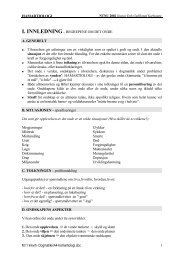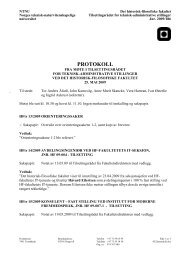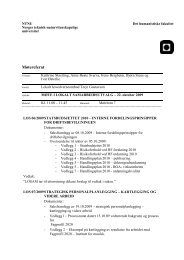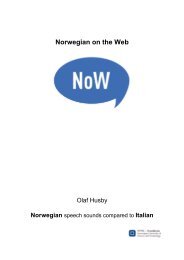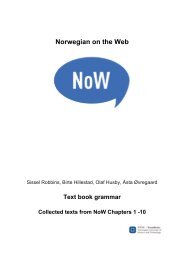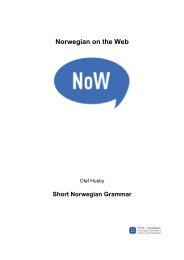In press: In: Dimitrova-Vulchanova, M - NTNU
In press: In: Dimitrova-Vulchanova, M - NTNU
In press: In: Dimitrova-Vulchanova, M - NTNU
You also want an ePaper? Increase the reach of your titles
YUMPU automatically turns print PDFs into web optimized ePapers that Google loves.
1. Background<br />
An important characteristic of language is that it imposes structure on the ‘reality’ it<br />
represents (Jackendoff 1996, Talmy 1985, 2000) by selecting for ex<strong>press</strong>ion only specific<br />
concepts and features. As a consequence, the linguistic ex<strong>press</strong>ion of spatial scenes, including<br />
motion, is constrained by a schema consisting of a closed class of elements like Motion, Path,<br />
Figure and Ground. Motion-event typology focuses on how these elements are encoded crosslinguistically.<br />
One of the most widely applied formats recently is Talmy’s (1985, 2000),<br />
which approaches motion encoding in language from two perspectives, that of linguistic form,<br />
and that of semantic content. <strong>In</strong> terms of linguistic form, the verb is viewed as the main<br />
lexical item encoding the motion event. Languages differ as to what elements of the motion<br />
situation they choose to bundle into their most frequently occurring basic motion verbs.<br />
According to these preferences, languages can be divided into several types, the most<br />
common being path-type languages and manner-type languages. From the perspective of<br />
semantic content and its interface with syntax, languages can be divided into two types,<br />
according to how they ex<strong>press</strong> the path of motion. <strong>In</strong> the so-called verb-framed languages<br />
(e.g. Spanish, Turkish, and Japanese), path is encoded in the verb in the main clause (enter,<br />
exit, ascend, etc.), while manner is specified most commonly in a subordinate clause. <strong>In</strong><br />
satellite-framed languages path is encoded in ‘satellites’ (e.g. adpositions in Germanic<br />
languages and verb prefixes in Slavic languages) which accompany the verb. Manner in such<br />
languages is encoded in the main verb of the clause, and typically those languages have a<br />
large number of commonly occurring manner of motion verbs. Although Talmy’s<br />
classification is useful and captures important insights in motion encoding, the rigidity of the<br />
system has engendered much debate. Many recent studies (e.g. Strömqvist & Verhoeven<br />
2004, Ameka & Essegbey 2000) have demonstrated that the data are more complex. Slobin<br />
(2004) argues that the preferential encoding of path vs. manner in verb roots is not a matter of<br />
belonging to one of two poles, but rather a cline along which manner salience can vary.<br />
Furthermore, there appears to be at least one more distinct type of language, where manner<br />
and path are ex<strong>press</strong>ed by equivalent semantic forms (e.g. verbs in serial-verb languages, cf.<br />
Ameka & Essegbey 2000, Zlatev & Yangklang 2004, among others).<br />
Typological research and Language Acquisition research (cf. Slobin 2001) indicate that<br />
the most frequent verbs of motion cross-linguistically and the ones that tend to be acquired<br />
early on in the process of language acquisition are generalized items denoting default motion<br />
scenes (e.g. scenes which are underspecified for global or local path shape, or parameters,<br />
2







